The first time I pruned a plum tree, I climbed into it and started snipping off stubby branches that looked good for nothing. They were kind of in my way too, snagging on my shirt. Hmm, the plum tree didn’t flower much that year. It set only six plums in total.
Pruning lesson number one, learned the hard way: Don’t cut off your fruiting wood.
Fruit trees don’t just grow their fruit anywhere and everywhere, you know? Go out and have a look at your trees. Here in early March is a perfect time to get to know their habits, as they’re all flowering or about to start, and they all flower in slightly different places.
Are the flowers at the tips of branches or are they along the sides? Are they on long or short branches? Are they on old, thick branches or young, thin branches?
Plums, Apricots, and Pluots
As I learned the hard way, plums flower mostly on stubby branches that you might be inclined to cut off. It so happens that apricots flower in a similar style — on “spurs,” the stubby branches are called.
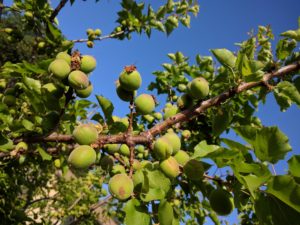
Same tree a month or so later (last year). Notice that most of the apricots are growing on spurs, not along the sides of long branches.
Pluots flower just like plums and apricots, mostly on spurs, but all three do flower somewhat along the sides of long branches as well.
Apples and Pears
Apples and pears flower, and so grow fruit, mostly on spurs too. But rather than flowering along the sides of long branches in addition, they flower in clusters at the very tips of long branches. Here is an example on a Fuji apple:
And here are flowers at the tip of a long branch on a Fan-stil pear:
So then, the mistakes you’d want to avoid while pruning apples and pears would be cutting off spurs as well as cutting off the tips of branches.
Peaches and Nectarines
Finally, we come to peaches and nectarines. Take a look at this Red Baron peach in full bloom last March:
See how it’s got flowers all along the sides of long, skinny branches? Peaches and nectarines don’t make spurs. They flower almost entirely on long, skinny branches that grew the summer before. These branches have bark that is red and green. Here is an example of a branch with red bark (whose underside is green):
Here is another branch on the same tree (Snow Queen nectarine). It will produce little to no flowers because it’s old. Note the gray color of its bark:
Don’t be deceived by the thickness of a peach or nectarine branch: sometimes a younger branch is thicker than an older one. The color of the bark tells the age, which tells you how much it’s likely to flower and fruit. Red with a green underside means it’s got that potential, so don’t cut it all off.
This isn’t to say that you shouldn’t cut off any fruiting wood. Pruning always entails removing some fruiting wood. We should just be aware of when we’re cutting off fruiting wood by noticing where our trees flower.
Check out your citrus, avocados, pomegranates, cherries, and whatever else you have too. Take advantage of this dynamic moment in the year to gain a more intimate understanding of where your trees grow their delicious fruit. And when it’s time to prune next, you won’t unwittingly chop off those ugly little branches that snag on your shirt. I never did it again. At least I learned my lesson.
All of my Yard Posts are listed HERE

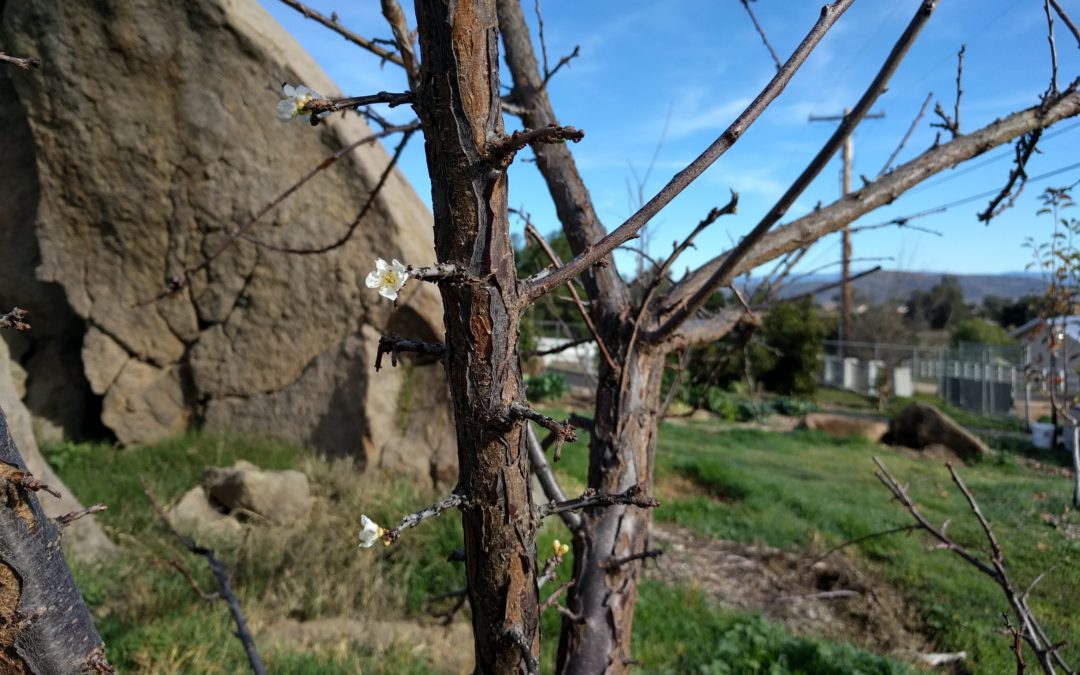

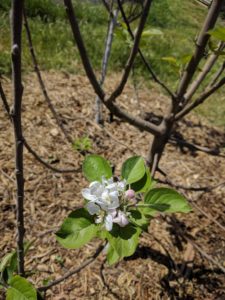
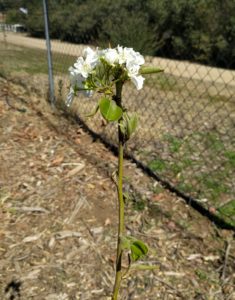
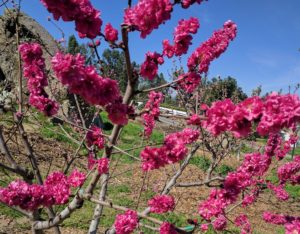
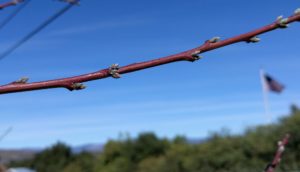
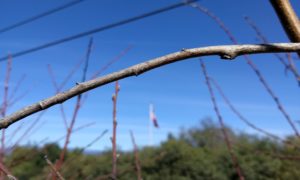


Hi Greg,
Thank you so much for taking the time to share this very welcome advice.
Hi Greg – I planted a small avocado tree in September. It is about 5 feet tall. When the weather frosted last month, I covered it with burlap the first night and burlap and a frost blanket thereafter. The branches are black and the leaves are falling off. The trunk is still green as are a few inches of branches near the trunk. What to do?
I should add that I live in San Diego and it is supposed to get really warm this week. Not sure if it will frost again this season.
Sorry to hear that. I experienced the same thing with an avocado tree I planted in November. That sucker frost was a real pain.
What to do now? Be careful about watering. Since the tree has few or no functioning leaves, it won’t be using much if any water so you run the risk of rotting the roots if the soil is kept too wet. Poke around with your fingers to check the soil moisture. Only water if it’s on the dry side.
Also, if any live (green) wood is exposed to the sun, then paint it with white latex paint. As dead leaves drop, this might happen.
About now the tree ought to begin pushing out new growth. Do no pruning yet. Just watch to see where the growth happens. After it’s clear where the dead limbs are, then you can prune those off.
I wouldn’t worry about more frost here in San Diego in late March. What we need to watch out for is a heat wave that burns the exposed branches. Paint them. Also, if it gets really warm soon, like over 80, you might want to shade the little tree on those days.
Hoping for the best for both of our baby trees!
Thank you Greg! I will follow your advice and let you know how it turns out. It is going to get very hot here this week, so I will make a shade for it.
When I pains the branches, how far up/down each branch should I paint?
Really appreciate your time and excellent advice.
Paint all bark that isn’t covered by the shade of leaves. Especially paint bark that faces south, west, and the top of any horizontal branches. I wrote this post last summer that you might like to read as it has a few photos and details: https://gregalder.com/yardposts/avocado-trees-get-sunburned-what-to-do/
Thank you Gred. Very much appreciated!
Great explanation and pictures gave a great understanding the BEST knowledge I have received in satisfying my thirst for USEFUL info
Many many THANKS
Thanks for the article. How can I identify whether my plum tree has set any flower buds that can fruit next year while it’s actively growing and not dropped the leaves for dormancy.